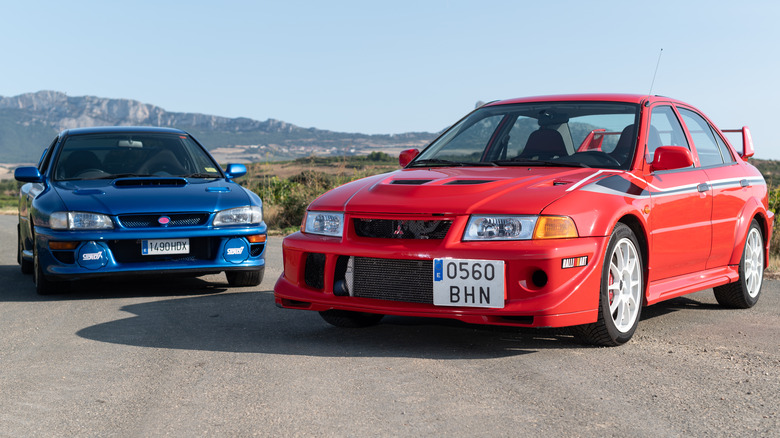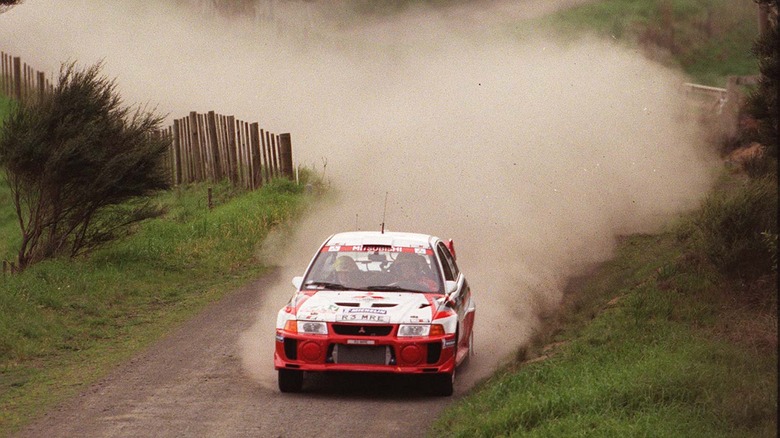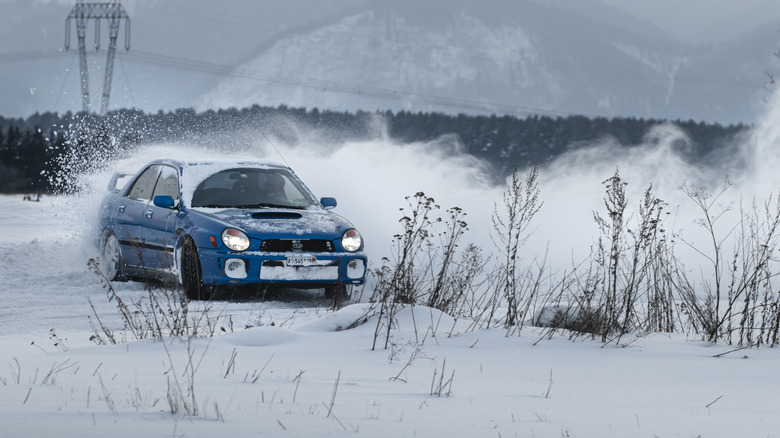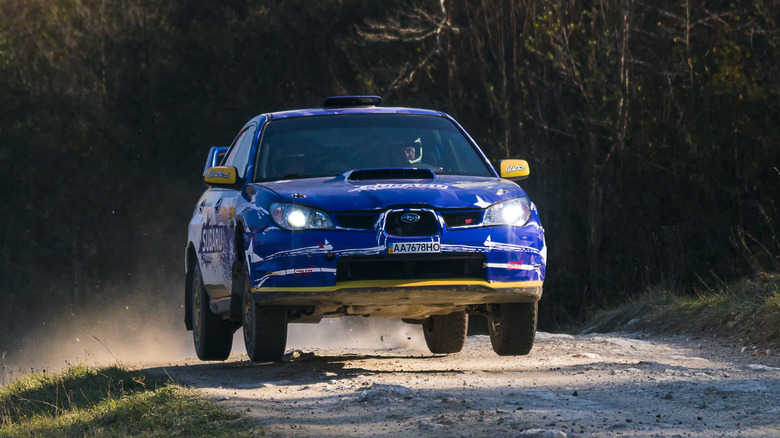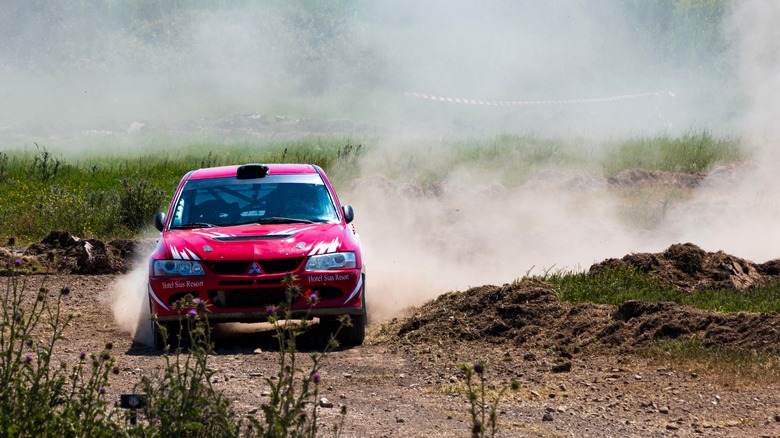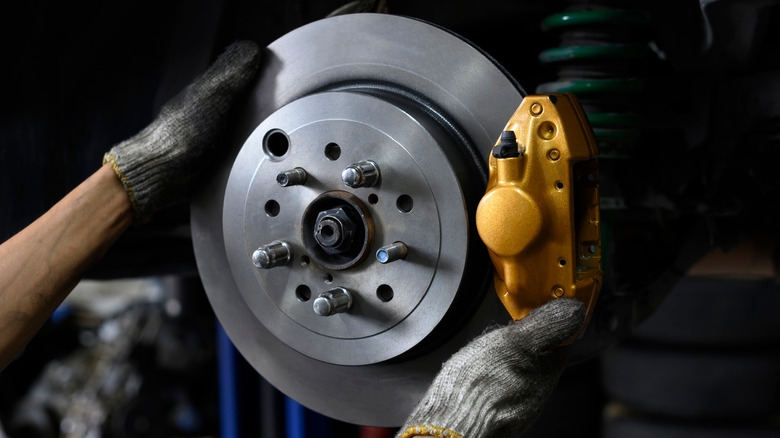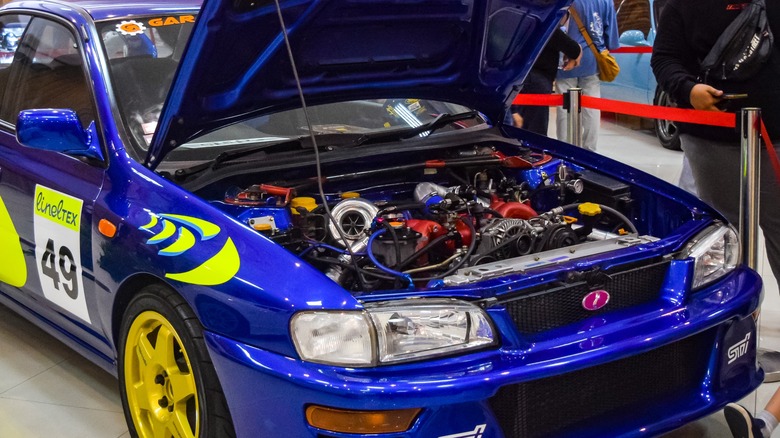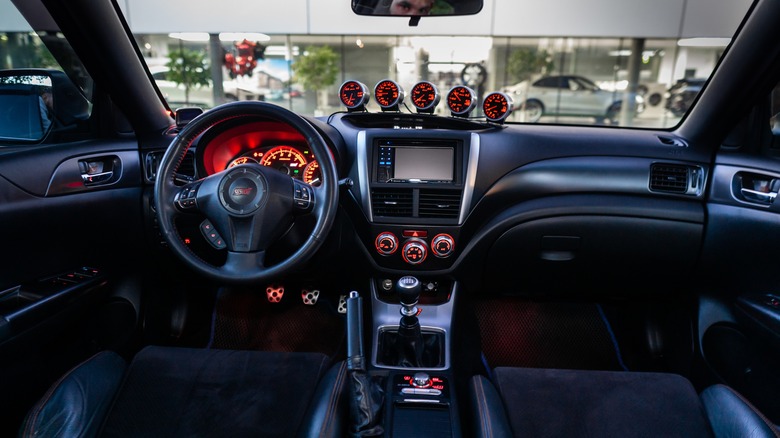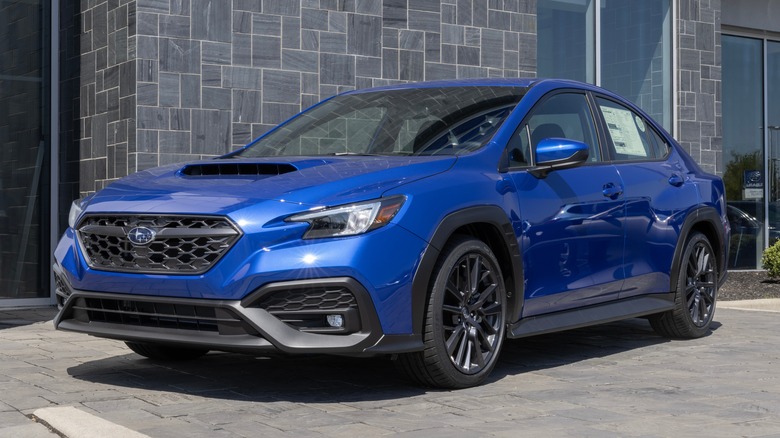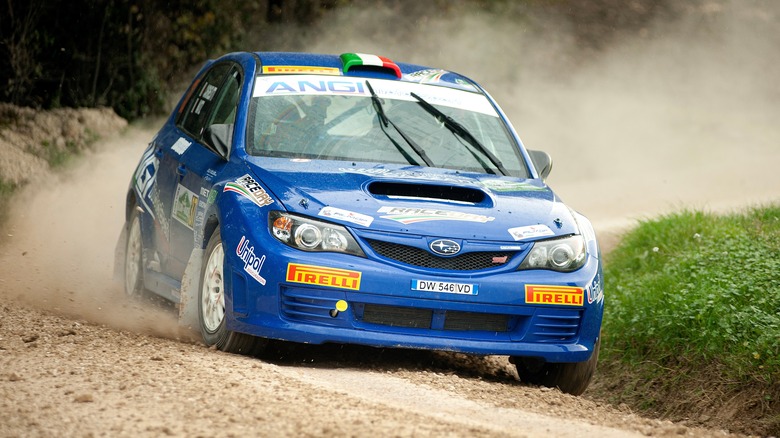Mitsubishi Lancer Evolution Vs. Subaru Impreza WRX: Which Is The Better Rally Car?
If you're a rally fan, two vehicles are likely to stand out when it comes to somewhat accessible rides with a legendary pedigree – the Subaru Impreza WRX and the Mitsubishi Evo. The two vehicles dominated the World Rally Championship throughout the mid-to-late 1990s, and in general there wasn't a lot between them.
There were some years when the Evo offered better performance, but it wasn't always outstandingly better. The Subaru, while being no slouch itself, would make up for its off years by being more accessible for those with limited funds. Beyond that, the Impreza is one of the most successful vehicle in WRC history, and it's hard to argue against something that just keeps winning.
Still, you can't just rely on spec sheets, either. It's easy to look at numbers and make claims based on which number is bigger or smaller, but being a better car on paper isn't everything. After all, rallying doesn't happen on paper, it happens on tarmac, gravel, mud, ice, sand, and — every so often — a ditch.
With all that in mind, let's compare some of the finer points of both cars and decide which is the better option if you want to go rallying.
Here's how the specs weigh up
In terms of rally success, both vehicles had their heydays in the mid-to-late 1990s. Due to this, it makes a lot of sense to pick a pair of vehicles from the end of the decade when comparing the two cars.
It's far easier to pinpoint the peak of the Lancer, which nabbed both the WRC Driver's and Manufacturer's championships for Mitsubishi in 1998. That year, the Mitsubishi was powered by a two-liter, 16-valve, turbocharged four-cylinder engine. It boasted 280 horsepower, 275 lb-ft of torque, capped out at 147 mph, and could go from 0-60 in just 4.7 seconds. The road-going variant of the 1998 Lancer Evo had a base curb weight of 2,998 lbs.
Conversely, the 1998 Impreza WRX packs 276 horsepower, 243 lb-ft of torque, and can manage a 4.5 second 0-60 time. It's a touch lighter at 2,756 pounds and has a top speed of 156 mph. If you're looking for a model with rally pedigree, then there is isn't much between the two. The Lancer may just have the edge on specs, and it was more successful in the 1998 season, but most years Subaru pulled ahead in the achievement department.
There's also an alternate choice as far as Subaru is concerned, if you can find it — the 1998 Subaru Impreza WRX STi Version V. The Version V is capable of pumping out 280 horsepower to achieve a roughly 4.5 second 0-60 time and a 150 mph top speed, making it capable of going toe-to-toe with Mitsubishi's highly decorated 1999 Lancer Evo.
How do the AWD systems compare?
When it comes to rallying, getting power to all four wheels is pretty vital. Audi demonstrated as much when the Quattro hit the scene in the early '80s and pretty much dominated — except for that Group B season in 1983 when Lancia managed to snatch the title amidst controversy.
However, not all four-wheel drive systems are created equally, and some will perform better in certain circumstances than others. Even if we had access to a couple of decades worth of cars and the resources to test out their all wheel drive systems, getting definitive results would be pretty difficult. So we have to try to come to some sort of consensus based on driver feedback. It's also going to vary from year to year.
If you browse forums, message boards, and other online outlets, you'll probably find that seemingly more drivers prefer Subaru's all-wheel drive system over Mitsubishi's. This isn't definitive, and plenty of people have praised the incredible amount of grip that the Lancer is capable of finding, but Subaru has seemingly won a lot of people over with its system.
How did they perform in the WRC?
With 46 rally wins, three driver's championships, and three manufacturer's championships, the Subaru Impreza is arguably the greatest rally car of all time. It's certainly the most successful, should you be judging things on wins alone. It has also added to the legacies of some of the best known drivers in the world, including Colin McRae, Carlos Sainz Sr., and Petter Solberg.
While the Mitsubishi Lancer Evo was extremely competitive throughout this period, it only managed to notch up a single manufacturer's championship win. The vehicle did help Mitsubishi snag a driver's championship four years running, from 1996 to 1999, but the genius of Tommi Mäkinen played a large part there. Mäkinen won more rallies than any other Mitsubishi driver, and 22 of his 24 total wins came behind the wheel of a Lancer Evo.
Still, if we're comparing the two cars on rally credentials alone, the Impreza wins outright.
How about the cost?
With the Mitsubishi Lancer Evolution, if you're basing things on past achievements alone you'll want a 1998 model. According to data gathered by Classics.com, one of those will set you back around $33,000 — which is right in the middle of the pack for used Lancers. If you really need this car and are looking for a dirt-cheap example, then 1993 models are averaging just over $10,000. On the other end of the scale, some Lancer Evos from the early 2000s can sell for figures north of $40,000. Like many classics, the Lancer seems to be undergoing somewhat of a renaissance in recent years.
A 1999 WRX Sti will also set you back around $33,000 according to Classics.com, but that's about as bad as it gets with a golden age Impreza. Many of the better years seem to be selling for between $20,000 and $25,000 with options available from as low as $13,000. First-gen Impreza WRXs tend to come in between $10,000 and $20,000 and may be an ideal option. Even if you don't have rallying in mind, you're still getting a very reliable used car at that price.
So, as it was when both vehicles were new, the Subaru remains the more affordable option. If you want to take a car rallying, being somewhat cheap is a huge advantage, as that extra money saved on the initial purchase can go towards parts that will improve the vehicle. It's also less of a pain if you mess up and write something off. As far as price goes, the Subaru Impreza wins this round.
What about parts?
If you're intent on racing, aftermarket parts are pretty vital. Although both cars were built well, throwing a stock Impreza WRX or Lancer Evo onto a rally stage might not end too well. Ideally, you'll upgrade things like the suspension, fit a sequential gearbox, and slap a heftier skid plate onto the vehicle. Racing is hard on cars in general and rallying is particularly harsh on a vehicle, so the chances are parts will start to fail somewhere along the line and need to be replaced.
Between talking yourself into fancier parts, constant tinkering, and inevitable damage repairs, parts are an area that can really hit you hard in the wallet. So the price and availability of parts is something to strongly consider when you're choosing a vehicle. The good news is, you can't really go wrong with either car. The Lancer Evo and Impreza WRX were both immensely popular, especially amongst rally fans. As a result, aftermarket parts are pretty plentiful and can be found cheaply online, so you're spoiled for choice whatever you pick.
While both vehicles have cheaper options when it comes to parts, the Subaru seems to have a slight edge when it comes to keeping component costs down. So if you're not planning on remortgaging your house to invest in the best parts available, owning a Subaru might be a touch kinder on your wallet.
What about engine maintenance?
In addition to the punishment the vehicle's suspension will take from all of the jumps and bumps, the engine is going to take a bit of a battering too. There's a good chance you'll be accelerating hard and often while attempting to post a good time. A hard-working engine takes punishment anyway, and it all gets a bit worse if the thing is running hot in the middle of a tough day's racing. So engine maintenance is pretty important, and parts are likely to fail and need replacing at regular intervals anyway. If professional racing teams are constantly fixing things in the garage, what chance do you have?
Boxer engines, which you'll find in almost every Subaru, have their advantages. They keep the center of gravity low, let you fit that hefty intercooler on top, are arguably safer in a crash, and are a bit more efficient than more orthodox options. The downside is that they're a bit of a pain to work on. The more traditional straight four in the front of the Lancer is closer to what many people will be used to and if you're going to spend a lot of time under the hood your life will probably be significantly easier with the Evo.
What about getting it race ready?
If you're buying a car to rally with you have two options — you can shell out for a car that's race ready, or just get something stock and deck it out yourself. Each option has its pros and cons. If you do your research and buy from someone reputable, a race ready car is the easier option. It likely ticks all of the safety boxes, and will save you the bother of agonizing over things like shock absorbers. If you love racing, but struggle with the mechanical side of things, then it allows you to avoid all that and likely save on mechanics fees. However, if you can do it yourself then something race ready is probably a far more expensive option.
If you can do it yourself, then you're not likely to find much of a difference when it comes to things like fitting rally shocks, or changing the wheels. We're also talking about two of the most popular racing vehicles in history, so aftermarket parts shouldn't be a struggle to source.
What may give the Subaru a mild edge is the amount of interior space available. The roomier Impreza makes a roll cage easier to fit, and they won't let you compete in a rally without a roll cage. That extra room also comes in handy during a race, as your helmet-clad head is less likely to come into contact with said cage every time you take a corner or hit a bump — something that tends to constantly happen while rallying.
What about something more modern?
If late '90s isn't your thing and you want a modern vehicle with a rally pedigree, then you may be considering the latest Lancer Evo or Impreza WRX. Unfortunately, both companies have moved on to some degree, so you may be out of luck.
Subaru basically wins this one by default. The Impreza WRX is no longer a thing on paper, but what actually happened is the Japanese company split the WRX from the Impreza line back in 2014. We found plenty to appreciate about the 2022 Subaru WRX when we reviewed it, but it is only available as a full-sized sedan, while the Impreza is more focused on the hatchback form factor these days. Subaru still enters the WRX into various races, including some that are associated with the World Rally Championship.
Anyone hoping for a brand new Lancer are completely out of luck. Mitsubishi discontinued its popular rally car back in 2017, so if you're looking for a Lancer you're forced to go second hand. This may not be a problem if you're just looking for something to race with, although for those looking for something that can double as a daily driver this may rule a Lancer Evo out. In addition to lacking comforts that have become standard over the last decade, a Lancer will likely have many of the issues cars approaching a decade old tend to get. If you're turning something into a rally car, you may not want to spend time to have to deal with this on top of your other expenses.
The Impreza is your best option
If you're going for pure performance, there are some years when the Mitsubishi Lancer Evo is an obvious choice. However, you're likely to pay more for the vehicle in the first place, pay more for its parts, and have a slightly harder time getting it kitted out for racing. That said, unless you opt for one of the few Subarus that doesn't have a boxer engine fitted, you may have an easier time working on an Evo.
The Subaru is cheaper, has an arguably better all-wheel drive system, and had some excellent model years that can go toe to toe with the best Mitsubishi has to offer. You really can't overlook the Impreza's successes on the rally stage either. It's one of the most successful vehicles to ever hit the rally course, so you have an objective point of reference if you want to claim it's the best option to go rallying in. Conversely, the Lancer won fewer races, only snagged one manufacturer's championship, and arguably had most of its success thanks to its driver Tommi Mäkinen.
So while there still isn't a ton between the two vehicles, and you're unlikely to be upset with either option, the Impreza has the edge.
